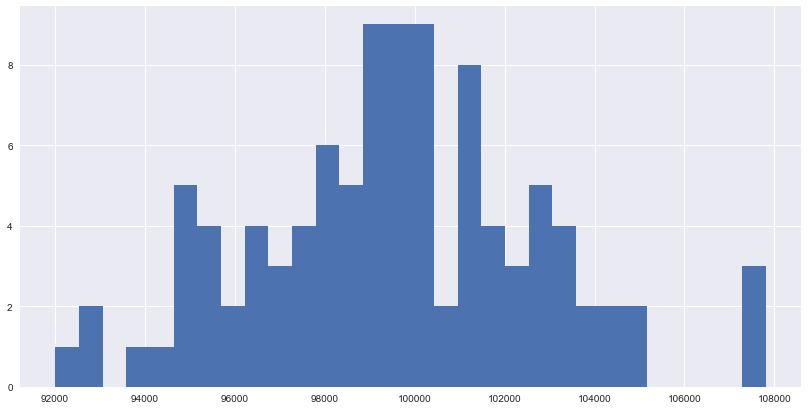引用Numpy
import numpy as np
生成随机数据
# 200支股票 stock_cnt = 200 # 504个交易日 view_days = 504 # 生成服从正态分布:均值期望=0,标准差=1的序列 stock_day_change = np.random.standard_normal((stock_cnt, view_days)) # 使用沙盒数据,目的是和书中一样的数据环境,不需要注视掉 # stock_day_change = np.load('../gen/stock_day_change.npy') # 打印shape (200, 504) 200行504列 print(stock_day_change.shape) # 打印出第一支只股票,头五个交易日的涨跌幅情况 print(stock_day_change[0:1, :5])
3.1.3 索引选取和切片选择
# 0:2第一,第二支股票,0:5头五个交易日的涨跌幅数据 stock_day_change[0:2, 0:5]
3.1.4 数据转换与规整
# 2代表保留两位小数 np.around(stock_day_change[0:2, 0:5], 2)
3.1.5 逻辑条件进行数据筛选
mask = stock_day_change[0:2, 0:5] > 0.5
print(mask)
3.1.6 通用序列函数
# np.all判断序列中的所有元素是否全部是true, 即对bool序列进行与操作 # 本例实际判断stock_day_change[0:2, 0:5]中是否全是上涨的 np.all(stock_day_change[0:2, 0:5] > 0)
# np.any判断序列中是否有元素为true, 即对bool序列进行或操作 # 本例实际判断stock_day_change[0:2, 0:5]中是至少有一个是上涨的 np.any(stock_day_change[0:2, 0:5] > 0)
# 对两个序列对应的元素两两比较,maximum结果集取大,相对使用minimum为取小的结果集 np.maximum(stock_day_change[0:2, 0:5], stock_day_change[-2:, -5:]) # array([[ 0.38035486, 0.12259674, -0.2851901 , -0.00889681, 0.45731945], # [ 0.13380956, 2.03488293, 1.44701057, -0.92392477, 0.96930104]])
change_int = stock_day_change[0:2, 0:5].astype(int) print(change_int) # 序列中数值值唯一且不重复的值组成新的序列 np.unique(change_int)
# diff 前后临近数据进行减法运算 # axis=1 np.diff(stock_day_change[0:2, 0:5])
# 唯一区别 axis=0 np.diff(stock_day_change[0:2, 0:5], axis=0)
#where 数据筛选 tmp_test = stock_day_change[-2:, -5:] print(np.where(tmp_test > 0.5, 1, 0))
统计概念与函数使用
stock_day_change_four = stock_day_change[:4, :4] print('最大涨幅 {}'.format(np.max(stock_day_change_four, axis=1))) print('最大跌幅 {}'.format(np.min(stock_day_change_four, axis=1))) print('振幅幅度 {}'.format(np.std(stock_day_change_four, axis=1))) print('平均涨跌 {}'.format(np.mean(stock_day_change_four, axis=1)))
3.2.2 统计基础概念
a_investor = np.random.normal(loc=100, scale=50, size=(100, 1)) b_investor = np.random.normal(loc=100, scale=20, size=(100, 1)) # a交易者 print('交易者期望{0:.2f}元, 标准差{1:.2f}, 方差{2:.2f}'.format(a_investor.mean(), a_investor.std(), a_investor.var())) # b交易者 print('交易者期望{0:.2f}元, 标准差{1:.2f}, 方差{2:.2f}'.format(b_investor.mean(), b_investor.std(), b_investor.var()))
正态分布
import scipy.stats as scs # 均值期望 stock_mean = stock_day_change[0].mean() # 标准差 stock_std = stock_day_change[0].std() print('股票0 mean均值期望:{:.3f}'.format(stock_mean)) print('股票0 std振幅标准差:{:.3f}'.format(stock_std)) # 绘制股票0的直方图 plt.hist(stock_day_change[0], bins=50, normed=True) # linspace从股票0 最小值-> 最大值生成数据 fit_linspace = np.linspace(stock_day_change[0].min(), stock_day_change[0].max()) # 概率密度函数(PDF,probability density function) # 由均值,方差,来描述曲线,使用scipy.stats.norm.pdf生成拟合曲线 pdf = scs.norm(stock_mean, stock_std).pdf(fit_linspace) # plot x, y plt.plot(fit_linspace, pdf, lw=2, c='r')

# 100个赌徒进场开始,胜率0.45,赔率1.04,手续费0.01 moneys = [casino(0.45, commission=0.01, win_once=1.02, loss_once=0.98) for _ in np.arange(0, gamblers)] _ = plt.hist(moneys, bins=30)

伯努利分布